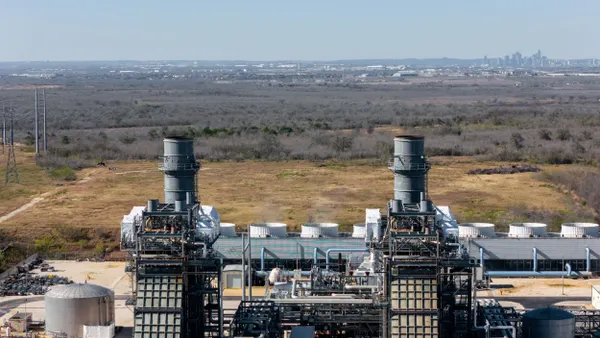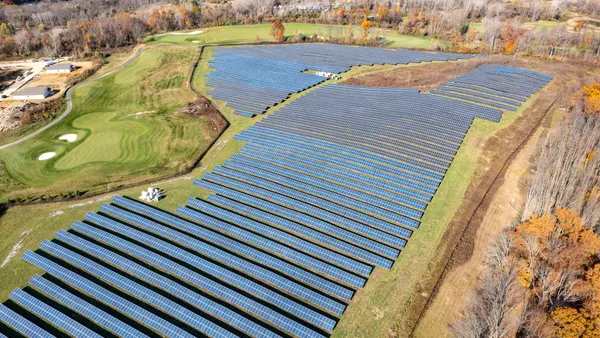Dive Brief:
- An Arizona mandate to achieve 100% clean energy by 2050 could ultimately drive utility bills higher by about $60 a month, according to a new independent analysis from Ascend Analytics. However, the report and clean energy advocates warn the long-term nature of the projection means it should be taken "with a grain of salt," as new technologies could help lower costs.
- Ascend Analytics concluded that for the state's largest utility, Arizona Public Service (APS), a 100% clean energy mandate could drive monthly customer bills higher by $43.98 to $49.19 by 2050. For Tucson Electric Power (TEP), bill increases would range from $15.61 to $58.23 per month, on average. The estimates include inflation at 2.5%.
- The Arizona Corporation Commission (ACC) has spent years considering clean energy targets and mandates, but in May it voted against proposed rules for the state that targeted decarbonization of electric utilities by 2050. The commission will use the new independent analysis to consider utility clean energy proposals it receives, it said.
Dive Insight:
The ACC voted to hire Ascend Analytics in April, just before ending a three-year collaborative process to transition the state's generation to 100% clean resources. But utilities have set their own decarbonization goals, and the new analysis can help regulators understand what those may cost.
"Now that we have the cost information we've requested, we can discuss the pros and cons of the proposed clean energy objectives openly and transparently and let customers guide our decision on whether to adopt the proposed rules," ACC Chair Lea Márquez Peterson said in a statement.
"I could not in good conscience support mandates that were not supported by cost data," Márquez Peterson said. "Without proper oversight, adopting mandates without knowing the cost impacts to consumers would be like handing utilities a blank check."
Since voting against the clean energy proposal in May, the ACC has restarted a rulemaking process to consider a longer-term 2070 target. However, utilities are still moving ahead with more aggressive plans. APS has set a 100% clean energy goal by 2050, with a 2030 target of 65% clean energy. TEP plans to get 70% of its power from wind and solar by 2035.
According to the report, reaching 50% clean energy by 2035 will have more modest bill impacts. Ascend concluded a typical APS residential customer would see bills between about $13.32 and almost $14 more per month than they would have been without the 50% carbon reduction. TEP customers would see monthly bills that are $0.07 to $12.40 higher.
If utilities achieve 80% clean energy by 2050, Ascend sees a typical APS residential bill reaching between $11.84 and $18.41 more per month than it would have been absent that reduction. For TEP, the 80% by 2050 target could mean customers pay between $1.56 and $40.33 more per month.
The amounts include 2.5% inflation; the report says that "in 2050 dollars, $60 is equivalent to about $30 in today's dollars."
APS, in a statement, said it supports the commission's efforts to develop new energy rules. The utility said it is on track with its own commitment to serving customers with a 100% carbon-free energy mix by 2050.
"Our planning goal is to keep costs low by leveraging the right combination of clean resources, collaborative partnerships and supportive policy," the utility said. The Ascend report "shows that an 80% clean energy mix is achievable and cost-effective with today's technology assumptions."
The utility added that "we're confident that innovation in technology will help us manage costs and deliver 100% clean and carbon-free electricity, while maintaining affordability and reliability for our customers."
TEP said the utility believes decarbonizing the power sector "can be achieved cost-effectively over the next two decades, with 80% of energy sourced from clean energy resources," as reflected in the Ascend study. "These results are consistent with other industry studies and TEP's 2020 Integrated Resource Plan."
Take results with 'a grain of salt'
Clean energy advocates warn the report's conclusions are uncertain due to the lengthy outlook, and the report's authors agree this is true.
"As with any very long-range study, results in the distant future must be taken somewhat with a grain of salt," the report notes. "We have little information as to what technologies will be available or how exactly the power system will evolve."
The study has other limitations, the authors note. The analysis may undervalue flexible resources such as battery storage because of how future energy prices are analyzed, and it has also not been paired with a loss of load probability analysis.
Battery storage is a significant component of utility decarbonization plans. Regulators recently approved a pilot for APS to use residential storage for grid optimization, and the utility is planning to install 850 MW of four-hour battery storage by 2025, the Ascend report noted.
The study also considers only three discrete scenarios, "none of which were optimized," the authors said. "A more thorough study would leverage capacity expansion algorithms as well as discrete sensitivities to test key assumptions."
Nicole LaSlavic, executive director of the Arizona Solar Energy Industries Association, was blunt about the limitations of the research, saying it is likely to turn out "very wrong." Among its flaws, she said, the study fails to consider water savings associated with renewable energy use, which "is absolutely essential to Arizona right now."
"The assumptions the report makes are so speculative as to be nearly meaningless when you look at the longer term assumed costs," LaSlavic said in an email. "A decade ago, no one would have predicted the price declines we have seen with solar, and the same is likely going to be true for battery storage going forward."
CORRECTION: Ascend Analytics issued a correction to its calculations of Arizona Public Service monthly bill increases. It now estimates that a 100% clean energy mandate by 2050 could increase monthly bills by up to $49.19. We have updated the article and headline to reflect the changes.














